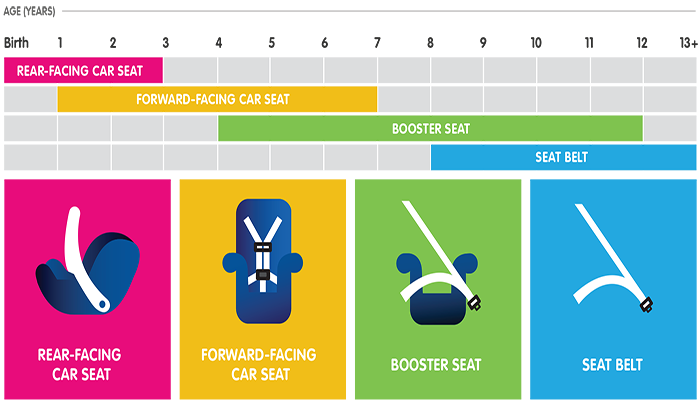Car seat recommendations: Choosing the right seat

| Rear-facing car seat | Forward-facing car seat | Booster seat | Seat belt |
|---|---|---|---|
| Your child under age 1 should always ride in a rear-facing car seat in the back seat. There are different types of rear-facing car seats: Infant-only seats can only be used rear-facing. Convertible and 3-in-1 car seats typically have higher height and weight limits for the rear-facing position, allowing you to keep your child rear-facing for a longer period of time. | Keep your child rear-facing as long as possible. It’s the best way to keep him or her safe. Your child should remain in a rear-facing car seat until he or she reaches the top height or weight limit allowed by your car seat’s manufacturer. Once your child outgrows the rear-facing car seat, your child is ready to travel in a forward- facing car seat with a harness in the back seat. | Keep your child in a forward-facing car seat with a harness until he or she reaches the top height or weight limit allowed by your car seat’s manufacturer. Once your child outgrows the forward-facing car seat with a harness, it’s time to travel in a booster seat, but still in the back seat. | Keep your child in a booster seat until he or she is big enough to fit in a seat belt properly. For a seat belt to fit properly the lap belt must lie snugly across the upper thighs, not the stomach. The shoulder belt should lie snug across the shoulder and chest and not cross the neck or face. Remember: your child should still ride in the back seat because it’s safer there. |
| A rear-facing car seat is the best seat for your young child to use. It has a harness and in a crash, cradles and moves with your child to reduce the stress to the child’s fragile neck and spinal cord. | A forward-facing car seat has a harness and tether that limits your child’s forward movement during a crash. | A booster seat positions the seat belt so that it fits properly over the stronger parts of your child’s body | A seat belt should lie across the upper thighs and be snug across the shoulder and chest to restrain the child safely in a crash. It should not rest on the stomach area or across the neck. |
| Reduce the risk of death and injury by properly securing your child. To maximize safety, keep your child in the car seat for as long as possible. |
Car crashes are a leading killer of children ages 1 to 13.
In crashes from 2007-2011, 3,668 children (under 13 in cars and light trucks) were killed. An estimated 641,000 children under 13 were injured.
That's more than the population of Boston, MA.
In 2011, 656 children (under 13 in cars and light trucks) were killed in crashes.
Of those killed, more than 1 in 3 were unrestrained.
Car seats reduce the risk of infants (under 1 year old) being killed in cars by 71%.
Car seats reduce the risk of toddlers (1 to 4 years old) being killed in cars by 54%.
National Highway Traffic Safety Administration